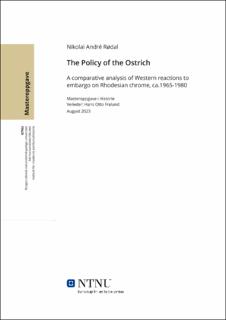| dc.contributor.advisor | Frøland, Hans Otto | |
| dc.contributor.author | Rødal, Nikolai André | |
| dc.date.accessioned | 2023-09-22T17:19:34Z | |
| dc.date.available | 2023-09-22T17:19:34Z | |
| dc.date.issued | 2023 | |
| dc.identifier | no.ntnu:inspera:144861566:37439331 | |
| dc.identifier.uri | https://hdl.handle.net/11250/3091459 | |
| dc.description.abstract | I denne oppgaven diskuterer jeg hvilken innvirkning FNs sanksjoner mot Rhodesia hadde på vestlige lands strategier, med tanke på deres avhengighet av krom. Europeisk importavhengighet for krom ligger på rundt 90-100% på 1970-tallet, og denne importavhengigheten legger grunnlaget for deres strategi innen kromhandel. Fokuset for analysen sammenligner strategiene til USA og det Europeiske Fellesskap (EF), på grunn av deres ledende rolle i ferrokromproduksjon på begynnelsen av oppgavens tidsramme, rundt 1965. Ferrokromindustrien i Europa og USA svekkes i forhold til det sørlige Afrika, som drar nytte av teknologiske framskritt for å raskt bygge opp egen ferrokromindustri, som svekker vestlige smelteverk, samtidig som avhengigheten av det sørlige Afrika blir større og større.
Oppgaven skaper et bilde av en industri som er i stor endring – hvor endringer i produksjonsmønster av ferrokrom fører til at flere land bryter med sanksjoner, mens USA er de eneste som gjør det åpenlyst i form av Byrd Amendment. Oppgaven viser at amerikansk utenrikspolitikk var drevet av ideologiske likheter og frykt for å bli avhengig av sovjetisk krom. Samtidig førte EF en strategi som holdt kromhandel, og handel for øvrig under jorden, noe som gjør det vanskelig å bevise graden av sanksjonsbryting som ble gjennomført av EF. Både USA og EF var sannsynligvis involvert i kromhandel under sanksjonene, men EFs politikk var i større grad under jorden, mens USAs handel med Rhodesia var gjort i åpenhet. | |
| dc.description.abstract | In this paper, I will be discussing the impact that the UN sanctions against Rhodesia had on Western countries' strategies, considering their dependence on Rhodesian chrome. European import dependency for chromium is around 90-100% in the 1970s, and this import dependency forms the basis of their chromium trade strategy. The focus of this analysis is to compare the strategies of the United States and the European Community (EC), due to their large ferrochrome industries around the year 1965. The ferrochrome industry in Europe and the US was becoming weaker in relation to Southern Africa, which was taking advantage of technological advances to rapidly build up its own ferrochrome production capacity, weakening Western industries, who were becoming increasingly dependent on Southern Africa for ores.
The paper creates a picture of an industry that was undergoing major change - where changes in ferrochrome production patterns led several countries to violate sanctions, while the US was the only one to do so openly in the form of the Byrd Amendment. The paper shows that American foreign policy was driven by ideological similarities and fear of becoming dependent on Soviet chromium. At the same time, the EC pursued a strategy that kept the chromium trade, and trade in general, underground, which makes it difficult to prove the degree of sanctions busting carried out by the EC. Both the US and the EC were likely to have been involved in chrome trade during the sanctions, but the EC's policy remained covert, while the US trade with Rhodesia was done openly. | |
| dc.language | eng | |
| dc.publisher | NTNU | |
| dc.title | The Policy of the Ostrich: A comparative analysis of Western reactions to embargo on Rhodesian chrome, ca.1965-1980 | |
| dc.type | Master thesis | |
